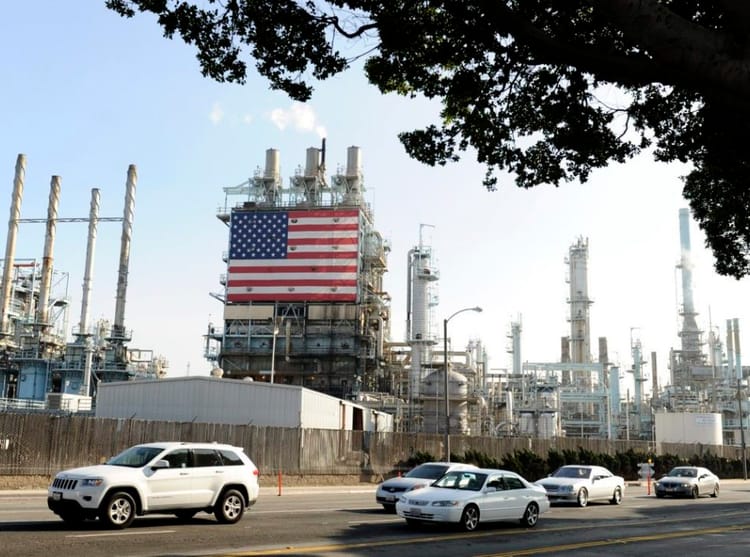Drilled Down: Manchin's Inflation Reduction Act—What's Good and Bad for Climate

Weird coincidence: My power was out when the Inflation Reduction Act of 2022 was announced. By the time it came back on, Twitter was awash in takes on what Senator Joe Manchin's proposal means for climate. Quick aside here, how annoying is the dude who shits on everyone else's proposal and then finally submits his own worst-of-all-versions approach as the most sensible path forward? We've all worked with this dude at some point, and he is no one's favorite.
Negotiating on climate policy with Senator Coal Baron began with the first iteration of the Build Back Better Act, which earmarked more than $500 billion for climate-related programs. That was still less than half of what is needed to actually transition off of fossil fuels, but it was a start and clean energy advocates were particularly excited about the Clean Electricity Performance Program, which would have required electric utilities to clean up their electricity mixes by 4 percent each year. That doesn't sound like much, but even the fastest-moving utilities were hitting around 2 percent each year (2020 was the best year on record, when the utility sector hit a 2.3 percent increase in clean energy), so the mix of regulation and incentives aimed at pushing them to 4 percent would have delivered meaningful emissions reductions. It was one of the first programs Manchin killed; he said utilities were already moving quickly enough. The fee proposed on methane emissions went too (it's back now!), as did a whole host of other regulatory measures.
"What we've seen is that carrots are much easier to pass than sticks," Dr. Leah Stokes, professor of political science at University of California at Santa Barbara and author of the book Short Circuiting Policy, about the way utilities have influenced and controlled energy policy over the years, told me at the time. "It's really hard to actually require change," she adds. "It's a lot easier to say, 'Hey, if you'd like to go solar, cool! Here's some money. But you know, you don't have to. You want an EV? Sure, that's great. But you know, you don't have to get an EV. Everything is just kinda voluntary and that's important. Don't get me wrong. Carrots are really important. But the problem with climate change is that we actually have to move fast enough. We need everybody to be doing the right thing at the pace and scale that's necessary."
And therein lies the rub. Politicians are still treating climate change like, well, politics. In doing so they're missing the one really key difference between this issue and every other issue they might address: time. If Washington fucks up on healthcare, people will die, it's true. But we're not locked into mass death year over year, compounding and increasing all the time with no way to stop it. A new policy could literally stop the bleeding from one day to the next. The same is not true of climate. A compromise today may well be smart politics, but it is also genocide. It is a choice to put corporate profits above human life, and not just the humans walking around right now but also those who will walk the Earth 50 years from now. It's the sort of thing that makes me wonder all the time whether politics is just fundamentally incapable of meeting this challenge.
Which is not to say that doing something, anything isn't always better than doing nothing. Every percentage of a degree matters, and despite the fact that this Act supports fossil fuel extraction alongside clean energy development, on the whole we will emit less than had Manchin proposed absolutely nothing. So, with our climate realist glasses on, let's take a look at the details of this proposal, which Manchin and Schumer agreed to and announced on July 27, 2022, and which they say could be law as early as August 2022.
The Weeds
This is a 725-page bill, and I have not read every single page yet, so please if there are climate provisions I've missed, give me a shout. The section begins on page 232, and it starts with "Clean Electricity and Reducing Carbon Emissions." Here's what it does (I've put ** next to provisions that were part of the original BBB climate proposal):
- **Extends renewable energy production credits to 2025
- ** Increases the credit for facilities providing apprenticeship programs and good wages by a factor of 5 – so massively rewards companies that are supplying good-paying "green jobs" and related training, this is huge.
- **Provides a 10 percent bonus production tax credit if 40 percent or more of the steel, iron, or components of a facility was produced in the United States
- **Extends and expands the investment tax credit. The credit would cover any "qualified energy property," that starts construction by January 1, 2025, and the definition of "qualified energy property" would be expanded to include solar energy property, geothermal energy property and heat pumps, fiber-optic solar equipment, fuel cell property, micro turbine property, combined heat and power property, small wind energy property, biogas property, waste energy recovery property and offshore wind property. Newly eligible property under the expanded ITC includes energy storage technology, biogas property, micro grid controllers, dynamic glass and linear generators
Okay, here we have our first red flag: biogas. Otherwise known as "renewable natural gas," biogas is the methane emissions from concentrated animal operations or landfills. Gas companies are into biogas because it allows them to tell a good green story while locking in gas infrastructure. By even the most optimistic estimate, RNG could only cover about 16 percent of current gas use, the rest would be supplied by the usual fossil gas. Is it worth capturing methane if we can? Sure. Is it worth using that captured methane as fuel? Maybe. Although it's not the emissions-free panacea it's often painted as--captured methane burns the same as regular old methane, eventually generating greenhouse gas emissions. Should we encourage the expansion of the biogas market as part of a climate solution? No. The reality is, we don't need to. Gas companies will take it to its limit in an effort to keep people hooked on gas anyway. Back to the proposal, though. It also:
- Provides a 10 percent bonus investment tax credit if a facility is located in an "energy community," meaning a community historically associated with the extraction of coal, oil, or natural gas (interesting because in the initial BBB version, oil and gas communities were excluded).
- ** All of the bonus tax credits go from 10 to two percent if a company is not delivering on jobs and wages.
- ** Increases tax credits for solar and wind projects servicing low-income communities.
- ** Extends the credit for carbon oxide sequestration facilities that begin construction before the end of 2033. To qualify, direct air capture facilities must capture no less than 1,000 metric tons of carbon oxide per year. Electricity generating facilities must capture no less than 18,750 metric tons of carbon oxide and 75 percent of total carbon emissions.
Red flag #2: No matter how you feel about direct-air capture or carbon sequestration, most folks agree that if you want a tax credit for it, you can't be using it for "enhanced oil recovery"—injecting it into the ground to get more oil out. No such restrictions exist in this proposal.
- ** Provides a production credit for zero-emissions nuclear energy.
- Extends income and excise tax credits for biodiesel, renewable diesel and alternative fuels, but not for as long as the BBB originally suggested. This proposal extends them to 2024 instead of 2026.
Red flag #3: biofuels, really? Still? This is no doubt a handout to agribusiness, but if you're trying to get the emissions out of transportation, you invest in public transit and EVs.
- ** Production credit for clean hydrogen - The bill doesn't separate "blue hydrogen," which is made from natural gas, from "green hydrogen,"which is made via electrolysis powered by renewable energy. That's unfortunate, given that Bloomberg analysts have said this production credit would make both cost-competitive in the energy market.
- ** Clean energy and efficiency incentives for individuals. Taxpayers would be able to write off some of the cost of energy efficiency improvements (installing double-pane windows, for example, or skylights that reduce the need for electric lighting, but also bigger mechanical purchases like heat pumps.
- ** Extends the residential clean energy credit for another decade (and rebrands it, from "energy efficient property" to "clean energy tax credit")
- ** Extends, increases, and modifies the new energy efficient home credit. The credit would be extended to 2032, and provide a $2,500 credit for energy efficient single family and manufactured new homes, and $1000 for multi-family units meeting certain energy star requirements. The credit would go up to $5,000 for single family homes or multifamily units certified as a zero energy ready under the Department of Energy Zero Energy Ready Home Program.
- **Clean vehicle tax credits extended and modified. The restriction on the number of cars that would qualify for the credit has been lifted, and new requirements around the amount and source of critical minerals in batteries have been added. These new requirements stipulate that an increasing percentage of critical minerals be sourced from countries with which the U.S. has a free-trade agreement (side-eye in international arbitration)
- **Credit for used clean-car purchases too. This extends the credits for new car purchases to previously owned cars, both of which can now get $4000 or 30 percent of the sale price as a tax credit.
- ** Credit for commercial clean vehicles. This creates a new credit for qualified commercial electric vehicles, equal to 30 percent of the cost of the vehicle.
- ** Extends the alternative fuel vehicle refueling property credit through 2031. This includes both biofuel stations and electric charging stations.
- ** Extends the advanced energy project credit. There's a really broad spectrum of things that could qualify as an "advanced energy project" here, from a scrubber on the smokestacks of a powerplant to a carbon capture project, really any industrial product designed to reduce greenhouse gas emissions fits the bill.
- **Creates a new ITC and PTC for Advanced Manufacturing. This provision would create an investment tax credit worth up to 25 percent for advanced manufacturing facilities, and an advanced manufacturing production tax credit for eligible components. This will spur the manufacture of more heat pumps, solar panels, batteries, etc.
- ** Clean electricity production and investment credits. These provide incentives for utilities to embrace clean energy production more quickly.
- **Creates a tax credit for clean fuels production. To qualify for the credit the fuel’s lifecycle emissions must be at least 25 percent less than the current U.S. nationwide average. Zero-emission fuels qualify for a base incentive of $.20 per gallon or gallon equivalent. Sustainable aviation fuel that meets certain ASTM standards, and is not derived from palm oil, qualifies for a base incentive of $.35 per gallon or gallon equivalent.
- **Provides access to additional loans for renewable energy projects in rural areas.
- ** Funds the Rural Energy for America program, to provide financial assistance for underutilized renewable energy technologies and program technical assistance.
- ** Unlocks USDA funds for rural electric coops. The bill proposes $9.7 billion for grants and loans for certain electric cooperatives to purchase renewable energy or renewable energy systems, deploy renewable energy systems, or make energy efficiency improvements and to make grants for debt relief and other costs associated with terminating the use facilities operating on nonrenewable energy and related transmission assets.
- Funds wildfire prevention, via various forest management and conservation programs.
- **Funds energy efficiency, water efficiency, and/or climate resiliency upgrades to affordable housing projects.
- ** Invests in climate resilience in coastal communities. The bill provides $6 billion to the National Oceanic and Atmospheric Administration (NOAA), to remain available until September 30, 2026, to provide direct funding, grants, cooperative agreements and technical assistance to states, tribes, the District of Columbia, nonprofit organizations, local governments, and institutions of higher education for projects that conserve, restore, and protect coastal and marine habitats to increase climate resilience of coastal communities or sustain coastal and marine resource-dependent communities.
- **Bolsters forecasting and research. The bill provides additional funding to NOAA to further research, observation systems, modeling, forecasting, assessments, and dissemination of information to the public as it pertains to ocean and atmospheric processes related to weather, coasts, oceans, and climate.
- **Creates an Alternative Fuel and Low-Emission Aviation Technology Program at the Department of Energy, with a little over $300 million in funding until 2026.
- ** Rebates for home energy efficiency. The bill appropriates $4.3 billion for contractor training grants to support home energy efficiency retrofits and for state energy offices to provide rebates for retrofits.
- ** Funds State Energy Program grants to assist states and local communities adopting updated building energy codes for residential and commercial buildings.
- ** Funds loans to produce advanced technology medium and heavy-duty vehicles, trains or locomotives, maritime vessels, aircraft or hyperloop technology, and removes the cap on the amount each loan can be.
- ** Energy infrastructure reinvestment financing. This unlocks billions of dollars in funding for projects that "retool, repower, repurpose, or replace energy infrastructure that has ceased operations; or enable operating energy infrastructure to avoid, reduce, utilize, or sequester air pollutants or anthropogenic emissions of greenhouse gases."
- ** Funds the Tribal Energy Loan Guarantee Program.
- ** Funds new and replacement transmission infrastructure, including interstate electricity transmission lines, all of which is critical to electrification.
- ** Funds interregional and offshore wind electricity transmission planning, modeling and analysis.
- ** Provides financial assistance to projects for installing and implementing advanced industrial technology at energy-intensive industrial and manufacturing facilities.
- ** Authorizes leasing on the outer continental shelf for offshore wind.
Red flag #4 The fine print here mandates offshore oil leasing alongside offshore wind leasing...lest the oil companies be left out of the climate provisions, I guess? For the next ten years, it prohibits any offshore wind lease sales unless the Department of Interior has held at least one offshore oil and gas lease sale—for at least 60,000,000 acres—within the previous year. Similarly, leasing of public lands onshore must be paired with similar offerings for oil drilling over the next ten years. The Center for Biological Diversity accurately describes this as Manchin's poison pill hiding out in the bill. This, combined with some incredibly vague language around permitting, which could also be good for both renewables and fossil fuels, is a major slap in the face to frontline communities, especially when coupled with the fact that the lion's share of funding cuts from BBB to IRA are programs that would have directly benefited those communities.
- ** Raises the royalty rate for offshore oil and gas drilling to 16.5 to 18.5 percent (original BBB had it at 14)
- ** Rasies the royalty rate for onshore oil and gas drilling to 16.66 percent.
Red flag #5 – clearly no appetite here for shutting down fossil fuel production. But at least the government will get more revenue when it happens on federal lands? Those royalty rates haven't been raised since the 1920s.
- ** Grants and rebates for the purchase of clean heavy-duty vehicles.
- ** Establishes a Greenhouse Gas Reduction Fund, with $7 billion to fund the rapid deployment of low- and zero-emission technologies. Original BBB had earmarked $29 billion for this.
- ** Funding to address air pollution, from trucks and in schools.
- ** Funding for the EPA to carry out the American Innovation and Manufacturing Act,deploying new implementation and compliance tools, and awarding competitive grants for innovative reclamation and destruction technologies.
- Enhanced standardization and transparency in corporate greenhouse gas reporting, overseen by the EPA.
- Establishes a Methane Emissions Reduction Program by amending the Clean Air Act (interesting) to add incentives and funding for methane mitigation and monitoring. It does rely heavily on self-reporting from companies that we know have been underreporting their methane emissions for years, but it also includes a methane fee of $900/t in 2024 going up to $1500/t in 2026. Facilities that comply with the EPA methane regulations will be exempt from the fee. That's a high enough fee to do something, BUT the $850 million funding for the program is likely not enough to fix a key problem Earth Works' Sharon Wilson has pointed out to me a few times: You can have a meaningful regulation on paper but if you don't have enough staff to enforce it and the regulatory compliance is largely self-reported, you're not going to solve the methane problem. It also specifies funding for plugging and abating abandoned wells, but that's also work that companies are supposed to pay for, not the government.
- Establishes state greenhouse gas pollution planning and implementation grants. Again this is done by amending the Clean Air Act, which is interesting because one of the big arguments for whittling away at the EPA's ability to do anything on climate is the lack of explicit language in the Clean Air Act around climate change and greenhouse gas emissions. This proposal specifically appropriates $250,ooo,ooo for planning grants and $4.75 billion for implementation grants. It stipulates: "The Administrator shall make a grant to at least one eligible entity in each State for the costs of developing a plan for the reduction of greenhouse gas air pollution." As the kids say, big if true!
- Funds environmental justice block grants from the EPA. $3 billion in grants for: "community-led air and other pollution monitoring, prevention, and remediation, and investments in low- and zero-emission and resilient technologies and related infrastructure and workforce development that help reduce green house gas emissions; mitigating climate and health risks from urban heat islands, extreme heat, wood heater emissions, and wildfire events; climate resiliency and adaptation; reducing indoor toxics and indoor air
pollution; or facilitating engagement of disadvantaged communities in State and Federal public processes, including facilitating such engagement in advisory groups, workshops, and rulemakings. - Funding for U.S. Fish & Wildlife Service to climate-induced weather events. $121.5 million for rebuilding and restoring units of the National Wildlife Refuge System and State wildlife management areas to deal with extreme weather.
- ** Environmental and Climate Data Collection. This funds the Council on Environmental Quality to collect data on disproportionate negative environmental harms and climate impacts and the cumulative impacts of pollution and temperature rise, to track disproportionate burdens and cumulative impacts, and to ensure mapping and screening tool efforts are accessible to community-based organizations and community members.
- ** Establishes a preference for low-carbon materials in Federal buildings
- Provides funding for USPS clean fleet. This helps the USPS fund the purchase of zero-emission delivery vehicles
- ** Establishes and funds FEMA preference for low-carbon building materials and energy efficiency.
- ** Supports tribal climate resilience. This section of the bill earmarks funding for the Director of the Bureau of Indian Affairs (BIA) for tribal climate resilience and adaptation programs, BIA fish hatchery operations and maintenance programs, and for the administrative costs of carrying out tribal climate resilience and adaptation programs and fish hatchery operations and maintenance programs.
- ** Supports Native Hawaiian climate resilience. Provides funding to the Senior Program Director of the Office of Native Hawaiian Relations to carry out climate resilience and adaptation activities that serve the Native Hawaiian community by providing funding and technical assistance.
- ** Funds the Tribal Electrification Program. Provides funding for the provision of electricity to unelectrified tribal homes through renewable energy systems, as well as the transition of electrified tribal homes to renewable energy systems and associated retrofitting necessary to install renewable energy systems.
- Ensures "timely reviews." Each section of this proposal includes a mention of timely agency review. In most of them, permitting comes up. This has traditionally been a huge issue for renewable energy projects...but of course nothing in here would prevent permitting from being streamlined for oil and gas extraction too.
The Takeaway
In broad strokes, the bill provides about $369 billion for climate action, which Schumer has correctly described as the most the U.S. government has ever done on the issue. It provides funding for manufacturing clean energy products, cutting emissions, tech innovation, conservation, environmental justice, and more. It would also put the country on track to reduce emissions 40 percent by 2030. Ideally we'd be looking at more like $1 trillion and more than 50 percent reductions but 2030, but it's a helluva lot better than nothing.
If you've read this far...please consider upgrading your subscription to support our work! And if I missed, or misread, anything on the latest climate proposal here, please let me know (amy@criticalfrequency.org). Thanks!





